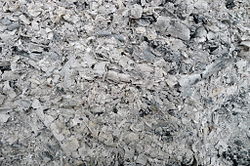This article needs additional citations for verification .(January 2016) |

| Part of a series on |
| Pollution |
|---|
 |
Ash is the solid remnants of fires. [1] Specifically, ash refers to all non-aqueous, non-gaseous residues that remain after something burns. In analytical chemistry, to analyse the mineral and metal content of chemical samples, ash is the non-gaseous, non-liquid residue after complete combustion.
Contents
- Natural occurrence
- Composition
- Wood and plant matter
- Specific types
- Cremation ashes
- Food ashes
- Joss paper ash
- Slash-and-burn ash
- Wildfire ash
- Others
- Other properties
- Aging process
- Global distillation
- Uses
- Fertilizer
- Laundry
- Health effects
- Effect on precipitation
- Effect on climate change
- See also
- References
Ashes as the end product of incomplete combustion are mostly mineral, but usually still contain an amount of combustible organic or other oxidizable residues. The best-known type of ash is wood ash, as a product of wood combustion in campfires, fireplaces, etc. The darker the wood ashes, the higher the content of remaining charcoal from incomplete combustion. The ashes are of different types. Some ashes contain natural compounds that make soil fertile. Others have chemical compounds that can be toxic but may break up in soil from chemical changes and microorganism activity.
Like soap, ash is also a disinfecting agent (alkaline). [2] The World Health Organization recommends ash or sand as alternative for handwashing when soap is not available. [3] Before industrialization, ash soaked in water was the primary means of obtaining potash.
